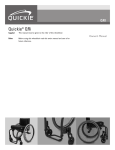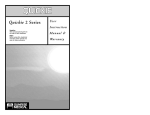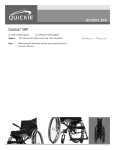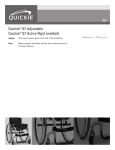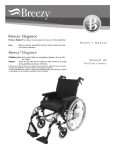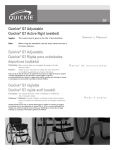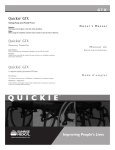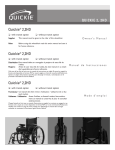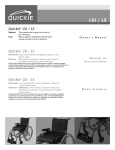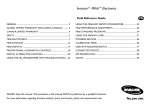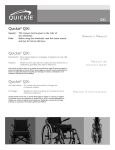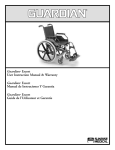Download Quickie® LXI/LX™ Owner`s Manual
Transcript
SECTION ENGLI SH LXI / LX Quickie® LXI / LX Supplier: This manual must be given to the user of this wheelchair. User: Before using this wheelchair read this entire manual and save for future reference. O w n e r ’s M a n u a l ENG LIS H I. INTRODUCTION SUNRISE MEDICAL LISTENS Thank you for choosing a Quickie wheelchair. We want to hear your questions or comments about this manual, the safety and reliability of your chair, and the service you receive from your Sunrise supplier. Please feel free to write or call us at the address and telephone number below: Sunrise Medical Customer Service Department 2842 Business Park Ave Fresno, CA 93727 (800) 333-4000 Be sure to return your warranty card, and let us know if you change your address. This will allow us to keep you up to date with information about safety, new products and options to increase your use and enjoyment of this wheelchair. If you lose your warranty card, call or write and we will gladly send you a new one. FOR ANSWERS TO YOUR QUESTIONS Your authorized supplier knows your wheelchair best, and can answer most of your questions about chair safety, use and maintenance. For future reference, fill in the following: Supplier:________________________________________________ Address:________________________________________________ _______________________________________________________ Telephone: ______________________________________________ Serial #: __________________ Date/Purchased: _______________ 930360 Rev. F 2 ENG LIS H II. TABLE OF CONTENTS I. II. III. IV. INTRODUCTION ............................................................... TABLE OF CONTENTS ...................................................... YOUR CHAIR AND ITS PARTS ....................................... NOTICE - READ BEFORE USE ......................................... A. Choose the Right Chair & Safety Options ................. B. Review This Manual Often ............................................. C.Warnings.............................................................................. V. GENERAL WARNINGS....................................................... A. Weight Limits .................................................................... B. Intended Use ..................................................................... C.Attendants and Caregivers.............................................. D. Accessories ........................................................................ E. Know Your Chair .............................................................. F. Reduce The Risk of an Accident ................................... G.Safety Checklist ................................................................. H.Changes & Adjustments .................................................. I. Environmental Conditions .............................................. J. Terrain ................................................................................. K. Street Use .......................................................................... L. Motor Vehicle Safety ........................................................ M.When You Need Help ..................................................... VI. SAFETY WARNINGS: FALLS & TIP-OVERS.................. A. Center of Balance ............................................................ B. Dressing or Changing Clothes ...................................... C.Obstacles ............................................................................ D. Front Caster Lift ................................................................ E. Reaching or Leaning .......................................................... F. Moving Backward............................................................... G.Escalators............................................................................. H.Ramps, Slopes & Sidehills ................................................ I. Transfer ................................................................................ J. Curbs & Single Steps......................................................... K. Climbing a Curb or Single Step...................................... L. Descending a Curb or Single Step................................. M.Stairs ..................................................................................... N.Climbing Stairs .................................................................. O.Descending Stairs ............................................................. VII. WARNINGS: COMPONENTS & OPTIONS ................. A. Anti-Tip Tubes ................................................................... B. Armrests ............................................................................. C.Cushion & Sling Seats ...................................................... D. Fasteners ............................................................................ E. Footrests.............................................................................. F. Pneumatic Tires ................................................................. 2 3 4 5 5 5 5 5 5 5 5 5 5 6 6 6 6 6 6 6 7 7 7 7 7 8 8 8 9 9 9 10 10 10 11 11 11 12 12 12 12 12 12 12 3 G.Positioning Belts Option .................................................. H.Push Handles Option........................................................ I. Quick-Release Axles ........................................................ J. Rear Wheels ...................................................................... K. Rear Wheel Locks ............................................................ L. Modified Seat Systems ..................................................... M.Seat and Back Upholstery .............................................. VIII. USE AND MAINTENANCE ............................................... A. Introduction ........................................................................ B. Critical Maintenance Tips................................................. C.Maintenance Chart ........................................................... D. Cleaning Tips....................................................................... E. Troubleshooting Chart ..................................................... F. To Mount and Remove Rear Wheels............................ G.Axles - Quick Release ...................................................... H.Wheel Locks....................................................................... I. Anti-tip tubes...................................................................... J. Flip Back Armrests............................................................. K. Flip-Back Height-Adjustable Armrests .......................... L. Single-Post Height Adjustable Armrests ....................... M.Swing-in/out Hangers and Footrests............................. N.Articulating or Elevating Legrest.................................... O.Backrest................................................................................ P. Cushion ................................................................................ Q.To Fold or Unfold your Wheelchair.............................. R. Check-Out .......................................................................... IX DEALER SERVICE AND ADJUSTMENT ......................... A. Dealer Service Introduction............................................ B. Critical Maintenance tips ................................................. C.Cleaning................................................................................ D. Axles - Threaded................................................................ E. Adjustable Axle Plate ........................................................ F. Toe-in Toe-out .................................................................... G.Caster Plates....................................................................... H.Caster Mounting ................................................................ I. Wheel Locks....................................................................... J. Anti-tip Tubes...................................................................... K. Height-Adjustable Armrests ........................................... L. Swing-in/out Hangers and Footrests............................. M.Backrest................................................................................ N Fitting the Jay Precision Back .......................................... O Seat Sling.............................................................................. 13 13 13 13 13 13 13 14 14 14 14 14 14 15 15 15 15 16 16 16 17 17 17 18 18 18 19 19 19 19 19 19 20 20 20 20 20 21 21 21 22 23 X. SUNRISE LIMITED WARRANTY ..................................... 23 930360 Rev. F ENG LIS H III. YOUR CHAIR AND ITS PARTS 1 1. Backrest 2. Push Handle 3. Armpad 4. Tire 5. Handrim 6. Quick-release axle 7. Anti-tip 8. Caster Wheel 9. Caster Fork 10. Footplates 11. Swing-away Hanger 12. Seat Sling 13. Seat Cushion 14. Flip-Back Height Adjustable Armrest 2 3 14 4 13 5 12 6 11 7 9 10 Note: All features may not be available with some chair setups or in conjunction with another chair feature. Please consult your authorized supplier for more information. 8 QUICKIE LXI / LX Casters Std - 8” pneumatic Opt - 5”, low-profile polyurethane, 6” pneumatic, 6” polyurethane, 8” polyurethane, 3/4” longer fork stem bolt, 1 1/2” longer fork stem bolt Standard Rear Wheels Std - mag Opt - spoke Backrest 8o with push handles 16”-19”, 14”-17” Backrest options: solid back, backrest cushion, straight push handles Armrests Std - flip-back with standard pad Opt - padded swing-away, flip-back with fulllength pad, flip-back height-adjustable with standard pad, flip-back height-adjustable with full-length pad. Tire types Std - pneumatic Opt - pneumatic with airless insert, full-profile polyurethane, low-profile polyurethane Hanger Type 60o, 70o, 90o, articulating legrest-adult, elevating, 90o elevating Axle Plates Standard, adjustable Handrims Std - aluminum Opt - plastic-coated, long tabs Weight 28 lbs. with steel rear axles Frame Dimensions Frame width: 12”- 20” (seat width 1/2” narrower) Sling depth: 12”-18” Footplates Composite, foam, adult angle-adjustable, kids angle-adjustable, extended, heel loops, legstrap Footrest extension tubes: short, medium, long, high mount Axles Std - threaded Opt - quick -release, quad-release axle nuts Anti-tip Tubes Rear anti-tip tubes, front anti-tip tubes Tire Size Std - 24” Opt - 20”, 22” Projections Opt - vertical, oblique, 6, 8, 10, 12 Wheel Locks Std - high-push Opt - high-pull, omit, do not mount, 6” extension handles, grade aids . 930360 Rev. F 4 ENG LIS H IV. NOTICE– READ BEFORE USE A. CHOOSE THE RIGHT CHAIR & SAFETY OPTIONS C. WARNINGS Sunrise provides a choice of many wheelchair styles to meet your needs. This product is intended for single person use only. Final selection of the type of wheelchair, options and adjustments rests solely with you and your health care professional. Choosing the best chair for your unique mobility needs, will depend on such things as: The word “WARNING” refers to a hazard or unsafe practice that may cause severe injury or death to you or to other persons. The “Warnings” are in three main sections, as follows: 1. V — GENERAL WARNINGS Here you will find a safety checklist and a summary of risks you need to be aware of before you ride this chair. 1. Your disability, strength, balance and coordination. 2. The types of hazards you must overcome in daily use (where you live and work, and other places you are likely to use your chair). 3. The need for options that will improve your positioning, safety and comfort (such as anti-tip tubes, positioning belts, or special seating systems). 2. VI– SAFETY WARNINGS: FALLS & TIP-OVERS Here you will learnabout practices for the safe use of your chair, and how to avoid a fall or tip-over while you perform daily activities in your chair. B. REVIEW THIS MANUAL OFTEN 3. VII — WARNINGS — COMPONENTS & OPTIONS Here you will learn about the components of your chair and options you can select for safety. Consult your authorized supplier and your health care advisor to help you choose the best set-up and options for safe use. Before using this chair you, and each person who may assist you, should read this entire manual and make sure to follow all instructions. Review the warnings often, until they are second nature to you. NOTE– Where they apply, you will also find “Warnings” in other sections of this manual. Heed all warnings in these sections. If you fail to do so a fall, tip-over or loss of control may occur and cause severe injury to the rider or others. V. GENERAL WARNINGS A. WEIGHT LIMITS C. ATTENDANTS AND CAREGIVERS WARNING WARNING NEVER exceed the weight limit specified by Sunrise Medical. The weight capacity provided by your manufacturer is for the combined weight of a rider and items carried using on-board storage. If you do exceed the weight limit, damage to your chair, a fall, tip-over or loss of control may occur and cause severe injury to the rider or others. Before you assist a rider, be sure to read all warnings contained in this manual, and follow all instructions that apply. Be aware that after consulting a healthcare advisor, you will need to learn safe and proven body mechanics to use and create assistive methods best suited to your abilities. Weight Capacities D. ACCESSORIES WARNING Quickie LX - 250lbs/(113Kg). Quickie LXI - 265lbs/(120kg). Unauthorized modifications or use of parts, or accessories not supplied or approved by Sunrise Medical may change the chair structure. This will void the warranty and may cause a safety hazard. B. INTENDED USE The Quickie LX Series of wheelchair's intended use is to provide mobility to persons limited to a sitting position. Some problems that may occur, but are not limited to: 1. Incorrect Wheels and/or tires that put the rider at risk of a fall or tipover. 2. Adding a component to the frame, changing the structural integrity of the chair. 3. Any modification or disassembly can potentially create an unsafe situation where rider and/or attendant are put at risk. WARNING DO NOT use this device for purposes other than what is intended by the manufacturer 1. The wheelchiar is not designed for weight training and is unsafe for use as a seat while weight training. Weight training from the wheelchair substantially changes the stability of the chair and may cause tipping. 2. DO NOT stand on the frame of the wheelchair. 3. NEVER allow someone to stand on your chair or use it as a step ladder. 4. This chair is designed for a single rider only. 5. Unauthorized modifications and use of parts or accessories not supplied or approved by Sunrise Medical may change the chair structure. This will void the warranty and may cause a safety hazard. If the warning is ignored, damage to your chair, and the potential severe injury of the person using the chair for unintended purposes can occur. E. KNOW YOUR CHAIR WARNING Every wheelchair is different. Take the time to learn the feel of this chair before you begin riding. Start slowly, with easy, smooth strokes. If you are used to a different chair, you may use too much force and tip over. If you use too much force, damage to your chair, a fall, tip-over or loss of control may occur and cause severe injury to the rider or others. 5 930360 Rev. F ENG LIS H V. GENERAL WARNINGS F. REDUCE THE RISK OF AN ACCIDENT J. TERRAIN WARNING WARNING 1. BEFORE you begin riding, you should be trained in the safe use of this chair by your health care advisor. 2. Practice bending, reaching and transfers until you know the limit of your ability. Have someone help you until you know what can cause a fall or tip-over and how to avoid doing so. 3. Be aware that you must develop your own methods for safe use best suited to your level of function and ability. 4. NEVER try a new maneuver on your own. Ask the advice of your health care provider to lower the risk of a fall or tip over. 5. Get to know the areas where you plan to use your chair. Look for hazards and learn how to avoid them. 1. Based on ANSI/RESNA testing, Sunrise Medical recommends the use of a caster wheel with a minimum diameter of 5”, if the wheelchair will be overcoming obstacles up to 1/2” on a regular basis. 2. Your chair is designed for use on firm, even surfaces such as concrete, asphalt, indoor flooring, and carpets. 3. Do not operate your chair in sand, loose soil, or over rocky terrain. 4. If you use your chair on terrain that is rougher than described above there is a danger that screws and bolts will loosen prematurely, and that damage to wheels or axles could put the rider at risk of a fall, tip-over, or loss of control. K. STREET USE G. SAFETY CHECKLIST WARNING WARNING 1. This product is not intended for street use. 2. Avoid streets whenever possible. 3. Obey and follow all legal pedestrian pathways, and laws that apply to pedestrians. 4. Be alert to the danger of motor vehicles in parking lots, or if you must cross a road. Before Each Use Of Your Chair: 1. Make sure the chair rolls easily and that all parts work smoothly. Check for noise, vibration, or a change in ease of use. (This may indicate low tire pressure, loose fasteners, or damage to your chair). 2. Immediately repair any problem. Your authorized supplier can help you find and correct the problem. 3. Check to see that both quick-release rear axles are locked. When locked, the axle button will “pop out” fully. If not locked, the wheel may come off and cause you to fall. 4. If your chair has anti-tip tubes, lock them in place. If you fail to heed this warning, damage to your chair, and a possible collision may occur and cause severe injury to the rider or others. L. MOTOR VEHICLE SAFETY If possible and feasible, the rider should transfer to the Original Equipment Manufacturer vehicle seat and use the OEM vehicle restraint. H. CHANGES & ADJUSTMENTS WARNING WARNING Note– Transit only available on LXi model. To Identify whether your wheelchair has been manufactured with the Transit Option installed, look for four points of securement. Two Front points (A), and two rear points (B). 1. See your healthcare advisor and have them adjust seating components any time a change or adjustment needs to be made. 2. Unauthorized modifications or use of parts not supplied or approved by Sunrise may change the chair structure. This will void the warranty and may cause a safety hazard. If your chair is NOT equipped with the Transit Option: If you fail to heed these warnings damage to your chair, a fall, tip-over or loss of control may occur and cause severe injury to the rider or others. 1. NEVER let anyone sit in this chair while in a moving vehicle. a. ALWAYS move the rider to an approved vehicle seat. b. ALWAYS secure the rider with proper motor vehicle restraints. 2. In an accident or sudden stop the rider may be thrown from the chair. Wheelchair seat belts will not prevent this, and further injury may result from the belts or straps. 3. NEVER transport this chair in the front seat of a vehicle. It may shift and interfere with the driver. 4. ALWAYS secure this chair so that it cannot roll or shift. 5. Do not use any chair that has been involved in a motor vehicle accident. The frame and/or components may have been changed due to the accident. Such items could be, but are not limited to: bent, loosened, and/or broken components that were subjected to an impact. I. ENVIRONMENTAL CONDITIONS WARNING 1. Use extra care if you must ride your chair on a wet or slick surface. If you are in doubt, ask for help. 2. Contact with water or excess moisture may cause your chair to rust or corrode. Avoid all extreme weather situations if possible. a. Do not use your chair in a shower, pool or other body of water. The chair tubing and parts are not water-tight and may rust or corrode from the inside. b. Avoid excess moisture (for example, do not leave your chair in a damp bathroom while taking a shower). c. Dry your chair as soon as you can if it gets wet, or if you use water to clean it. Failure to heed these warnings puts you and others that may assist you at a high risk of injury. 1 A B If you fail to heed these warnings damage to your chair, a fall, tip-over or loss of control may occur and cause severe injury to the rider or others. 930360 Rev. F 6 ENG LIS H V. GENERAL WARNINGS M. WHEN YOU NEED HELP 4. To prevent injury to your back, use good posture and proper body mechanics. When you lift or support the rider or tilt the chair, bend your knees slightly and keep your back as upright and straight as you can. 5. Remind the rider to lean back when you tilt the chair backward. 6. When you descend a curb or single step, slowly lower the chair in one easy movement. Do not let the chair drop the last few inches to the ground. This may damage the chair or injure the rider. 7. To avoid tripping, unlock and rotate anti-tip tubes up, out of the way. 8. Whenever you aren’t attending the wheelchair, ALWAYS use the wheel-lock to secure the rear wheels, and lock the anti-tip tubes in place. WARNING For The Rider: Make sure that each person who helps you reads and follows all warnings and instructions that apply. For Attendants: 1. Work with the rider’s doctor, nurse or therapist to learn safe methods best suited to your abilities and those of the rider. 2. Tell the rider what you plan to do, and explain what you expect the rider to do. This will put the rider at ease and reduce the risk of an accident. 3. Make sure the chair has push handles. They provide secure points for you to hold the rear of the chair to prevent a fall or tip-over. Check to make sure push handle grips will not rotate or slip off. If you fail to ask for help when in doubt, you run a high risk of a fall, tipover or loss of control that may occur and cause severe injury to the rider or others. VI. SAFETY WARNINGS: FALLS & TIP-OVERS C. OBSTACLES A. CENTER OF BALANCE WARNING WARNING Riding over curbs or obstacles can cause tipping and serious bodily harm. If you have any doubt that you can safely cross any curb or obstacle, ALWAYS ASK FOR HELP. Be aware of your riding skills and personal limitations. Develop new skills only with the help of a companion. To avoid the risk of traversing obstacles: 1. Keep a lookout for danger – scan the area well ahead of your chair as you ride. 2. Make sure the floor areas where you live and work are level and free of obstructions. 3. Remove or cover threshold strips between rooms. 4. Install a ramp at entry or exit doors. Make sure there is not a drop off at the bottom of the ramp. 5. To Help Correct Your Center Of Balance: a. Lean your upper body FORWARD slightly as you go UP over an obstacle. b. Press your upper body BACKWARD as you go DOWN from a higher to a lower level. 6. If your chair has anti-tip tubes, do not go over an obstacle without help. 7. Keep both of your hands on the handrims as you go over an obstacle. 8. Never push or pull on an object (such as furniture or a doorjamb) to propel your chair. The point where this chair will tip forward, back or to the side depends on its center of balance and stability. How your chair is set up, the options you select and the changes you make may affect the risk of a fall or tip-over. 1. The Most Important Adjustment Is: The position of the rear wheels. The more you move the rear wheels forward, the more likely your chair will tip over backward. 2. The Center Of Balance Is Also Affected By: a. A change in the set-up of your chair, including: • The distance between the rear wheels. • The amount of rear wheel camber. • The seat height and seat angle. • Backrest angle. b. A change in your body position, posture or weight distribution. c. Riding your chair on a ramp or slope. d. A back pack or other options and the amount of added weight. 3. To Reduce The Risk Of An Accident: a. Consult your doctor, nurse or therapist to find out what axle and caster position is best for you. b. Consult your authorized supplier BEFORE you modify or adjust this chair. Be aware that you may need to make other changes to correct the center of balance. c. Have someone help you until you know the balance points of your chair and how to avoid a tip-over. d. Use anti-tip tubes. If you fail to heed these warnings damage to your chair, a fall, tip-over or loss of control may occur and cause severe injury to the rider or others. If you fail to heed these warnings, you are at a high risk of a fall, tip-over or loss of control that could cause severe injury to the rider or others. D. FRONT CASTER LIFT B. DRESSING OR CHANGING CLOTHES WARNING WARNING Front caster lift can occur when the front wheels, ordinarily in contact with the ground, are either intentionally, or unintentionally caused to lift from the ground while the rear wheels remain in contact. Pitch control (partial or full) should NEVER be attempted without consulting your healthcare advisor and making sure that anti-tips are installed. Your weight may shift if you dress or change clothes while seated in this chair. To reduce the risk of a fall or tip-over: 1. Rotate the front casters until they are as far forward as possible. This makes the chair more stable. 2. Lock anti-tip tubes in place. (If your chair does not have anti-tip tubes, back it up against a wall and lock both rear wheels). If you fail to heed this warning, you are at a high risk of damage to your chair, a fall, tip-over or loss of control that may occur and cause severe injury to the rider or others. If you fail to heed this warning, damage to your chair, a fall, tip-over or loss of control may occur and cause severe injury to the rider or others. 7 930360 Rev. F ENG LIS H VI. SAFETY WARNINGS: FALLS & TIP-OVERS E. REACHING OR LEANING 2. Always go as straight up and as straight down as you can. (Do not “cut the corner” on a slope or ramp.) 3. Do not turn or change direction on a slope. 4. When you have to use a ramp, always stay in the CENTER of the ramp. Make sure ramp is wide enough that you have no risk of going off the edge. 5. Do not stop on a steep slope. If you stop, you may lose control of your chair. 6. NEVER use rear wheel locks to try to slow or stop your chair. This is likely to cause your chair to veer out of control. 7. ALWAYS be aware of: a. Wet or slippery surfaces. b. A change in grade on a slope (or a lip, bump or depression). These may cause a fall or tip-over. c. A drop-off at the bottom of a slope or ramp. A drop-off as small as 3/4 inch can stop a front caster and cause the chair to tip forward. 8. To Reduce The Risk Of A Fall Or Tip-Over: a. Lean or press your body UPHILL. This will help adjust for the change in the center of balance caused by the slope or sidehill. b. Keep pressure on the handrims to control your speed on a down slope. If you go too fast you may lose control. c. Ask for help any time you are in doubt. 9. Ramps At Home & Work– For your safety, ramps at home and work must meet all legal requirements for your area: a. Avoid A Drop Off. You may need a section at the top or bottom to smooth out the transition. b. Always stay in the center of the ramp and control your speed. If you fail to heed these warnings damage to your chair, a fall, tip-over or loss of control may occur and can possibly cause severe injury to the rider or others. WARNING If you reach or lean it will affect the center of balance of your chair. This may cause you to fall or tip over. When in doubt, ask for help or use a device to extend your reach. 1. NEVER reach or lean if you must shift your weight sideways or rise up off the seat. 2. NEVER reach or lean if you must move forward in your seat to do so. Always keep your buttocks in contact with the backrest. 3. NEVER reach with both hands (you may not be able to catch yourself to prevent a fall if the chair tips). 4. NEVER reach or lean to the rear unless your chair has anti-tip tubes locked in place. 5. DO NOT reach or lean over the top of the seat back. This may damage one or both backrest tubes and cause you to fall. 6. If You Must Reach Or Lean: a. Do not lock the rear wheels. This creates a tip point and makes a fall or tip-over more likely. b. Do not put pressure on the footrests. c. Move your chair as close as you can to the object you wish to reach. d. Do not try to pick up an object from the floor by reaching down between your knees. You are less likely to tip if you reach to the side of your chair. e. Rotate the front casters until they are as far forward as possible. This makes the chair more stable. f. Firmly grasp a rear wheel or an armrest with one hand. This will help to prevent a fall if the chair tips. If you fail to heed these warnings damage to your chair, a fall, tip-over or loss of control may occur and cause severe injury to the rider or others. 2 3 F. MOVING BACKWARD WARNING Use extra care when you move your chair backward. Your chair is most stable when you propel yourself forward. You may lose control or tip over if one of the rear wheels hits an object and stops rolling. 1. Propel your chair slowly and smoothly. 2. If your chair has anti-tip tubes, make sure to lock them in place. 3. Stop often and check to be sure your path is clear. IF you need to go down a hill: a. The downslope should be less than 10° b. GO SLOW c. ALWAYS go straight down d. ALWAYS control your speed e. DO NOT Turn on the hill. If you fail to heed this warning, you are at a high risk of damage to your chair, a fall, tip-over or loss of control that may occur and cause severe injury to the rider or others. G. ESCALATORS 4 WARNING IF you need to go up a hill: a. The Upslope should be less than 10° b. ALWAYS go straight up c. NEVER stop on the upslope d. NEVER turn on a hill. e. ALWAYS lean forward. 5 NEVER use this chair on an escalator, even with an attendant. If you do, a fall or tip-over is likely. H. RAMPS, SLOPES & SIDEHILLS 2 3 4 IF you need to traverse a sidehill: a. The sidehill must be less than 6° or you risk a tip-over b. DON’T STOP c. ALWAYS go straight down d. DO NOT Turn on the hill. 5 WARNING Whenever possible, avoid riding on a slope, which includes a ramp or sidehill. This will change the center of balance of your chair. Your chair is less stable and more difficult to manuever. when it is at an angle. When moving up a hill, anti-tip tubes may not prevent a fall or tip-over. 1. Do not use your chair on a slope steeper than 10%. (A 10% slope means: one foot in elevation for every ten feet of slope length. 930360 Rev. F 8 IF you need to traverse a ramp: a. Go slowly b. Watch out for Drop-offs. c. ALWAYS go straight down. d. Stay centered on the ramp. e. ALWAYS lean forward. ENG LIS H VI. SAFETY WARNINGS: FALLS & TIP-OVERS I. TRANSFERS 6 Optimum Transfer position 7 6 WARNING It is dangerous to transfer on your own. It requires good balance and agility. Be aware that there is a point during every transfer when the wheelchair seat is not below you. To avoid a fall: 1. Work with your health care advisor to learn safe methods for transfers. a. Learn how to position your body and how to support yourself during a transfer. b. Have someone help you until you learn safe transfer methods. 2. Lock the rear wheels before you transfer. 3. Be aware that the chair can still slide and/or tip. The wheel lock keeps the rear wheels from rolling while you are perforrming the transfer. 4. Make sure that the pneumatic tires are properly inflated. Low tire pressure may allow the rear wheel locks to slip. (see table in Section G “Pneumatic Tires” 5. Move your chair as close as you can to the seat you are transferring to. If possible, use a transfer board. 6. Rotate the front casters until they are as far forward as possible. 7. If you can, remove the footrests, or swing them out of the way. a. Make sure your feet do not catch in the space between the footrests. b. Avoid putting weight on the footrests as this may cause the chair to tip. 8. Make sure armrests are removed, or out of the way and do not interfere with the transfer. 9. Transfer as far back onto the seat surface as you can. This will reduce the risk that the chair will tip or move away from you. 1. 2. GET GETREADY READY Before transferring, remove the armrests, and footrests, and make sure the wheel lock is set. 3. TRANSFER TRANSFER 9 7 ADJUST ADJUST 930360 Rev. F ENG LIS H J. CURBS & SINGLE STEPS VI. SAFETY WARNINGS: FALLS & TIP-OVERS 8 8 WARNING Before riding over curbs, and negotiating even a single step, ALWAYS ask for assistance first. Curbs and steps can cause tipping and serious bodily harm. When in doubt as to your ability to avoid, or traverse any obstacle, always ask for help. Be aware of your riding skills and personal limitations. Develop new skills only with the help of a companion. For Attendant: Each person who assists the rider with curbs and steps should read and follow all instructions and warnings pertaining to attendants, and caregivers. 1. Do not try to climb a high curb or step (more than 4 inches high) UNLESS you have help. Doing so may cause your chair to exceed its balance point and tip over. 2. Go straight up and straight down a curb or step. If you climb or descend at an angle, a fall or tipover is likely. 3. Be aware that the impact of dropping down from a curb or step can damage your chair or loosen fasteners. If you fail to heed these warnings damage to your chair, a fall, tip-over or loss of control may occur and can possibly cause severe injury to the rider or others. K. CLIMBING A CURB OR SINGLE STEP 8 WARNING For Attendant: follow these steps to help the rider climb a curb or single step going FORWARD: 1. Stay behind the chair. 2. Face the curb and tilt the chair up on the rear wheels so that the front casters clear the curb or step. 3. Move forward, placing the front casters on the upper level as soon as you are sure they are past the edge. 4. Continue forward until the rear wheels contact the face of the curb or step. Lift and roll the rear wheels to the upper level. If you fail to heed these warnings damage to your chair, a fall, tip-over or loss of control may occur and cause severe injury to the rider or others. L. DESCENDING A CURB OR SINGLE STEP 8 WARNING For Attendant:: Follow these steps to help a rider descend a curb or single step going BACKWARD: 1. Stay at the rear of the chair. 2. Several feet before your reach the edge of the curb or step, turn the chair around and pull it backward. 3. While looking over your shoulder, carefully step back until you are off the curb or stair and standing on the lower level. 4. Pull the chair toward you until the rear wheels reach the edge of the curb or step. Then allow the rear wheels to slowly roll down onto the lower level. 5. When the rear wheels are safely on the lower level, tilt the chair back to its balance point. This will lift the front casters off the curb or step. 6. Keep the chair in balance and take small steps backward. Turn the chair around and gently lower front casters to the ground. If you fail to heed these warnings damage to your chair, a fall, tip-over or loss of control may occur and cause severe injury to the rider or others. 930360 Rev. F 10 ENG LIS H M. STAIRS VI. SAFETY WARNINGS: FALLS & TIP-OVERS 9 9 WARNING 1. NEVER use this chair on stairs UNLESS you have someone to help you. Doing so is likely to cause a fall or tip-over. 2. Negotiating stairs with a wheelchair always requires at least 2 attendants for safety. If you fail to heed these warnings damage to your chair, a fall, tip-over or loss of control may occur and cause severe injury to the rider or others. N. CLIMBING STAIRS 9 WARNING 1. Use at least two attendants to move a chair and rider up stairs. 2. Move the chair and rider BACKWARD up the stairs. 3. The person at the rear is in control. He or she tilts the chair back to its balance point. 4. A second attendant at the front firmly grasps a non-detachable part of the front frame and lifts the chair up and over one stair at a time. 5. The attendants move to the next stair up. Repeat for each stair, until you reach the landing. If you fail to heed these warnings damage to your chair, a fall, tip-over or loss of control may occur and cause severe injury to the rider or others. O. DESCENDING STAIRS 9 WARNING 1. Use at least two attendants to move a chair and rider down stairs. 2. Move the chair and rider FORWARD down the stairs. 3. The person at the rear is in control. He or she tilts the chair to the balance point of the rear wheels and rolls it to the edge of the top step. 4. A second attendant stands on the third step from the top and grasps the chair frame. He or she lowers the chair one step at a time by letting the rear wheels roll over the stair edge. 5. The attendants move to the next stair down. Repeat for each stair, until you reach the landing. If you fail to heed these warnings damage to your chair, a fall, tip-over or loss of control may occur and cause severe injury to the rider or others. 11 930360 Rev. F ENG LIS H VII. WARNINGS: COMPONENTS AND OPTIONS A. ANTI-TIPS F. FOOTRESTS WARNING WARNING Anti-tip tubes can help keep your chair from tipping over backward in normal conditions. 1. Sunrise recommends the use of anti-tip tubes: 2. When locked in place (in the “down” position) anti-tip tubes should be BETWEEN 1 1/2 to 2 inches off the ground. a. If set higher than 2 inches, they may not prevent a tip-over. b. If set lower than 2 inches, they may “hang up” on obstacles and cause a fall or tip over. 3. If you have to climb or descend a curb, or overcome an obstacle it may be necessary to have an attendant make sure the anti-tip tubes are rotated up, and out of the way, so that the chair and rider do not get stuck and/or become unstable. 1. At the lowest point, footrests should be AT LEAST 2 inches off the ground. If set too LOW, they may “hang up” on obstacles you can expect to find in normal use. This may cause the chair to stop suddenly and tip forward. 2. To Avoid A Trip Or Fall When You Transfer: a. Make sure your feet do not “hang up” or get caught in the space between the footrests. b. Avoid putting weight on the footrests, as the chair may tip forward. c. Footrests should be swung out of the way or removed whenever entering or exiting the wheelchair. 3. NEVER lift this chair by the footrests. Footrests detach and will not bear the weight of this chair. Lift this chair only by non-detachable parts of the main frame. If you fail to heed these warnings damage to your chair, a fall, tip-over or loss of control may occur and cause severe injury to the rider or others. If you fail to heed these warnings damage to your chair, a fall, tip-over or loss of control may occur and cause severe injury to the rider or others. B. ARMRESTS WARNING E. PNEUMATIC TIRES WARNING Armrests detach and will not bear the weight of this chair. 1. NEVER lift this chair by its armrests. They may come loose or break. 2. Lift this chair only by non-detachable parts of the main frame. Proper inflation extends the life of your tires and makes your chair easier to use. 1. Do not use this chair if any of the tires are under- or over-inflated. Check weekly for proper inflation level, as listed on the tire sidewall. 2. Low pressure in a rear tire may cause the wheel lock on that side to slip and allow the wheel to turn when you do not expect it. 3. Low pressure in any of the tires may cause the chair to veer to one side and result in a loss of control. 4. Over-inflated tires may burst. If you fail to heed these warnings damage to your chair, a fall, tip-over or loss of control may occur and cause severe injury to the rider or others. C. CUSHIONS & SLING SEATS WARNING 1. Quickie sling seats and standard foam cushions are not designed for the relief of pressure. 2. If you suffer from pressure sores or if you are at risk that they will occur, you may need a special seat system or a device to control your posture. Consult your doctor, nurse or therapist to find out if you need such a device for your well-being. 3. Seat slings are not intended to be used as a direct seating surface. A cushion or other seating surface should be placed on the sling before use. If you fail to heed these warnings damage to your chair, a fall, tip-over or loss of control may occur and cause severe injury to the rider or others. Recommended Tire Pressures If you fail to heed these warnings damage to your chair, a fall, tip-over or loss of control may occur and cause severe injury to the rider or others. D. FASTENERS WARNING Many of the screws, bolts and nuts on this chair are special high-strength fasteners. Use of improper fasteners may cause your chair to fail. 1. ONLY use fasteners provided by an authorized supplier (or ones of the same type and strength, as indicated by the markings on the heads). 2. Over- or under-tightened fasteners may fail or cause damage to chair parts. 3. If bolts or screws become loose, tighten them as soon as you can. If you fail to heed these warnings damage to your chair, a fall, tip-over or loss of control may occur and cause severe injury to the rider or others. 930360 Rev. F 12 ENG LIS H VII. WARNINGS: COMPONENTS & OPTIONS H. POSITIONING BELTS (OPTION) K. REAR WHEELS WARNING WARNING Use positioning belts ONLY to help support the rider’s posture. Improper use of these belts may cause severe injury to or death to the rider. 1. Make sure the rider does not slide down in the wheelchair seat. If this occurs, the rider may suffer chest compression or suffocate due to pressure from the belts. 2. The belts must be snug, but must not be so tight that they interfere with breathing. You should be able to slide your open hand, flat, between the belt and the rider. 3. A pelvic wedge or a similar device can help keep the rider from sliding down in the seat. Consult with the rider’s doctor, nurse or therapist to find out if the rider needs such a device. 4. Use positioning belts only with a rider who can cooperate. Make sure the rider can easily remove the belts in an emergency. 5. NEVER Use Positioning Belts: a. As a patient restraint. A restraint requires a doctor’s order. b. On a rider who is comatose or agitated. c. As a motor vehicle restraint. In an accident or sudden stop the rider may be thrown from the chair. Wheelchair seat belts will not prevent this, and further injury may result from the belts or straps. I. PUSH HANDLES (OPTION) A change in set-up of the rear wheels will affect the center of balance of your chair. 1. The farther you move the rear axles FORWARD, the more likely it is that your chair will tip over backward. 2. Consult your healthcare advisor to find the best rear axle set-up for your chair. Do not change the set-up UNLESS you consult your healthcare advisor first. 3. Adjust the rear wheel locks after you make any change to the rear axles. a. If you fail to do so, the wheel locks may not work. b. Make sure lock arms embed in the tires at least 1/8 inch when locked. If you fail to heed these warnings damage to your chair, a fall, tip-over or loss of control may occur and cause severe injury to the rider or others. L. REAR WHEEL LOCKS WARNING Rear wheel locks are NOT designed to slow or stop a moving wheelchair. Use them only to keep the rear wheels from rolling when your chair is at a complete stop. 1. NEVER use rear wheel locks to try to slow or stop your chair when it is moving. Doing so may cause a fall or tip-over 2. To keep the rear wheels from rolling, always set both rear wheel locks when you transfer to or from your chair. 3. Low pressure in a rear tire may cause the wheel lock on that side to slip and may allow the wheel to turn when you do not expect it. 4. Make sure lock arms embed in tires at least 1/8 inch when locked. If you fail to do so, the locks may not work. 10 WARNING When you have an attendant, make sure that this chair has push handles. 1. Push handles provide secure points for an attendant to hold the rear of this chair, to prevent a fall or tip-over. 2. Check to make sure push handle grips will not rotate or slip off. If you fail to heed these warnings damage to your chair, a fall, tip-over or loss of control may occur and cause severe injury to the rider or others. If you fail to heed these warnings damage to your chair, a fall, tip-over or loss of control may occur and cause severe injury to the rider or others. 10 M. MODIFIED SEAT SYSTEMS WARNING Use of a seat system not approved by Sunrise may alter the center of balance of this chair. This may cause the chair to tip over. 1. Do not change the seat system of your chair UNLESS you consult your authorized supplier first. 2. Use of a seating system not approved by Sunrise may affect the folding mechanism of this chair. 3. Use of a seating system not provided by Sunrise is prohibited for transit use. N. SEAT AND BACK UPHOLSTERY WARNING J. QUICK-RELEASE AXLES WARNING 1. Replace worn or torn fabric of seat and seat back as soon as you can. If you fail to do so, the seat or seat back may fail. 2. Sling fabric will weaken with age and use. Look for fraying, thin spots, or stretching of fabrics especially at edges and seams. 3. “Dropping down” into your chair will weaken fabric and result in the need to inspect and replace the seat more often. 4. Be aware that laundering or excess moisture will reduce the flame retardation qualities of the fabric. 5. If Tension Adjustable upholstery is present, loosen straps or remove upholstery prior to folding or unfolding the chair. 1. Do not use this chair UNLESS you are sure that both quick-release rear axles are locked. 2. An axle is not locked until the quick-release button pops out fully. 3. An unlocked axle may come off during use, resulting in a fall, tip-over or loss of control and cause severe injury to the rider or others. • Quick-Release Axles should be periodically cleaned and inspected for function and signs of wear or bending. Replace as necessary. If you fail to heed these warnings damage to your chair, a fall, tip-over or loss of control may occur and cause severe injury to the rider or others. 13 930360 Rev. F ENG LIS H VIII. USE AND MAINTENANCE D. CLEANING WARNING 1. Paint Finish The owner of this chair is responsible for making sure that it has been setup and adjusted by a trained service professional under the advice of a healthcare advisor. The chair may require periodic maintenance or certain in-use adjustments that may be performed by the owner or caregiver. a. Clean the painted surfaces with mild soap or detergent at least once a month. b. Protect the paint with a coat of non-abrasive auto wax every three months. 2. Axles and Moving Parts A. INTRODUCTION a. Clean around axles and moving parts WEEKLY with a slightly damp (not wet) cloth. b. Wipe off or blow away any fluff, dust or dirt on axles or moving parts. 1. Proper maintenance will improve performance and extend the useful life of your chair. 2. Clean your chair regularly. This will help you find loose or worn parts and make your chair easier to use. You will need a mild detergent solution and plenty of cleaning rags. 3. If discovered, repair or replace loose, worn, bent or damaged parts before using the chair. 4. To protect your investment, have all major maintenance and repair work done by your authorized dealer. 5. Inspect and maintain this chair strictly per the maintenance chart. 6. If you detect a problem, make sure to order parts, or have service, and repair work done at your authorized dealer before use. 7. At least once per year, have a complete inspection, safety check, and service of your chair made by an authorized dealer. 3. Upholstery a. Hand-wash (machine washing may damage fabric). b. Drip-dry only. DO NOT machine dry as heat will damage fabric. 4. Basic Maintenance Materials available at local store a. b. c. d. Tire Pump Clean rags or cotten cloth. Teflon-based Lubricant Mild Detergent. NOTE– You do not need to grease or oil the chair. B. CRITICAL MAINTENANCE TIPS Caster flutter Squeaks and rattles Solution: Make sure tire pressure is correct and equal in both rear tires and front caster tires, if pneumatic. Make sure all nuts and bolts are snug. (Note: Do not overtighten or aluminum tubes may be damaged.) Check... Tire inflation level Wheel locks All fasteners for wear and tightness Make sure all spokes and nipples are tight on radial spoke wheels. Use Tri-Flow Lubricant (Teflon®-based) between all modular frame connections and parts. Symptom Annually 6 Months 3 Months Weekly C. MAINTENANCE CHART Sluggish turning 2. Axles & Axle Sleeves: When checking axles and axle sleeves every six months, make sure they are clean and tight. Loose sleeves will damage the axle plate and will affect performance. Looseness in chair Left turn in chair Check air pressure in pneumatic tires at least ONCE PER WEEK. The wheel locks will not grip properly if you fail to maintain the air pressure shown on tire sidewall. Right Turn in chair E. TROUBLESHOOTING CHART 1. Tire Air Pressure: Check for proper caster fork adjustment. See instructions for caster fork adjustment. Armrests Add a spacer washer between the plastic saddle and the caster plate on the top of the left caster plate. Axle and axle sleeves Add a spacer washer between the plastic saddle and the caster plate on the bottom right caster plate retaining bolts. Quick-release axles Wheels, tires and spokes Add a spacer washer between the plastic saddle and the caster plate on the top of the right caster plate. Casters Add a spacer washer between the plastic saddle and the caster plate on the bottom left caster plate retaining bolts. Anti-tip tubes Frame and crossbrace Make sure both front casters touch the ground simultaneously. if they do not, add spacers between the bottom bearing of the caster plate and fork stem nut until they do. Check for this on a flat surface. Upholstery Service by Authorized Supplier 930360 Rev. F 14 ENG LIS H VIII. USE AND MAINTENANCE F. TO MOUNT & REMOVE REAR WHEELS 11 11 WARNING Do not use this chair UNLESS you are sure both quick-release axles are locked. An unlocked axle may come off during use and cause a fall. A Note: Axle is not locked until: a. The quick-release button (A) pops out fully. b. The ball bearings are fully visible on the outside of the sleeve. 1. To Install Wheel: a. Depress quick-release button (A) fully. This will release tension on ball bearings at other end. b. Insert axle through hub of rear wheel. c. Keep pressure on button (A) as you slide axle (B) into axle sleeve (C) d. Release button to lock axle in sleeve. Adjust axle if it does not lock. e. Repeat steps on other side. C 12 B 2. To Remove Wheel: a. Depress quick-release button (A) fully. b. Remove wheel by sliding axle (B) out of axle sleeve (C). c. Repeat steps on other side. G. AXLES - QUICK RELEASE 12 a. b. c. d. Depress the quick-release button (A) on the axle. Slide through wheel hub and into axle sleeve until it locks. The axle is not secured until the outside quick-release button pops out to its fully extended position. The ball bearing on the opposite end of the axle must be fully visible beyond the end of the axle sleeve. e. Quick-Release Axles should be inspected for function and any signs of wear or bending. Replace as necessary. H. WHEEL LOCKS 13 13 Quickie LXI wheelchair are shipped with one of two types of high-mount wheel locks. WARNING Wheel locks are installed at Sunrise and should be adjusted by your qualified service person. Inspect wheel locks weekly per the maintenance chart. Do not use your chair UNLESS you are sure both wheel-locks can fully engage. A wheel-lock that is not correctly adjusted may allow your chair to roll, or turn unexpectedly. Wheel-locks must be adjusted after making sure the tires have the correct air pressure. When fully engaged, the arm should be imbedded into the tire at least 1/8” to be effective. 14 If you find the wheel locks have slipped or are not working correctly contact your service provider for proper adjustment. I. ANTI-TIP TUBES 14 15 Sunrise Medical recommends the use of Anti-tip tubes in every situation. NOTE: Use a torque setting of 115 in.-lbs. when setting up the anti-tip tubes. 1. Inserting Anti-Tip Tubes Into Receiver a. b. c. d. 2. Press the rear anti-tip release lever on the anti-tip tube so that both release pins are drawn inside. Insert into the anti-tip tube receiver. Turn the anti-tip tube down until release pin is through the receiver mounting hole. Insert second anti-tip tube the same way. 15 Turning Anti-Tip Tubes up. a. b. c. d. e. Press the rear anti-tip tube release lever. Hold lever in and turn anti-tip tube up. Release lever. Repeat with second anti-tip tube. Remember to return anti-tip tubes to down position after completing maneuver. 15 930360 Rev. F ENG LIS H VIII. USE AND MAINTENANCE 16 2. Adjusting Anti-Tip Tube Wheel 16 The anti-tip tube wheels may have to be raised or lowered to achieve the proper clearance of 1 1/2” to 2”. a. b. c d. Press the anti-tip wheel release button (A) so that both release pins are drawn inside. Raise or lower to one of the three predrilled holes. Release button. Adjust the second anti-tip tube wheel the same way. Both wheels should be at exactly the same height. J. FLIP-BACK ARMRESTS A 17 17 Flip-back armrests are shipped standard on Quickie LXI wheelchairs. They are installed by Sunrise. To flip armrests back, depress the release latch and pull arm toward back of wheelchair. K. FLIP-BACK HEIGHT ADJUSTABLE ARMRESTS 18 1 18 Flip-back height-adjustable armrests are installed by Sunrise. 4 1. Height-Adjustment a. Release the upper securing lever (2). b. Slide armpad (1) up or down to desired height. c. Return lever (2) to locked position. 6 2 5 2. Flipping Armrest Back and Removing Armrest 3 a. Depress the release latch (3) and pull arm toward back of wheelchair. b. To remove, pull up on armrest. Pin (6) securing armrest will automatically release. c. To return armrest to operating position, push armpad down until it locks firmly into place. Flip-Back Height Adjustable 1. 2. 3. 4. 5. 6. L. SINGLE-POST HEIGHT-ADJUSTABLE ARMRESTS 19 5 Armrest pad Upper securing lever Release latch Armrest panel Rear receiver Armrest release pin 19 4 3 1. Installation a. Slide the outer armpost (1)into the receiver (2) mounted to the wheelchair frame. b. The armrest will automatically lock into place. 2. Height Adjustment a. b. c. d. 2 Rotate release lever(3) to second stop. Slide armrest pad (4) up or down to desired height. Return lever (3) to locked position against armpost. Push arm pad until upper armpost locks firmly into place. 7 9 1 Height Adjustable 3. Removing Armrest 1. 2. 3. 4. 5. 6. 7. Outer Armpost Standard receiver Release lever Armrest pad Transfer bar Side panel Outer armpost tension adjustment set screws 8. Inner armpost 9. Receiver adjustment bolts a. Rotate release lever to first stop and remove the armrest. 4. Replacing Armrest a. Slide armrest back into receiver(2). b. Return release lever to locked position against armpost. 930360 Rev. F 8 16 6 ENG LIS H VIII. USE AND MAINTENANCE M. SWING-IN/OUT HANGERS AND FOOTRERSTS 20 20 A (60°, 70°, 70° “V”, or 90°) B 1. Installation a. Place swing-in/swing-out pivot saddle into the receiver (A) on front frame tube with the footrest facing outward from the frame. b. Rotate the footrest inward until it locks into place on locking bolt. 2. Removal a. To remove footrest, push release latch (B) toward the frame. b. Rotate footrest inward and lift. Or, pull footrest away from frame and rotate outward. C 3. Height Adjustment NOTE– It is recommended that you maintain a minimum of 2.0 inches between the lowest point on the footrest and the floor. a. Loosen set screw (C) using a 3/16 inch hex key. b. Slide footrest extension up or down inside frame tube to desired height. c. Tighten set screw. Use a torque setting of 144 in-lbs (16.27 Nm). 21 D N. ARTICULATING OR ELEVATING LEGREST 21 22 1. Installation a. To install or remove the Articulating legrest (ALR) or elevating legrest (ELR) see instructions above for (Swing-in/out hangers and Footrests) Articulating Legrest 2. Adjustment a. To raise legrest, lift to desired position. Legrest will automatically lock in place. b. To Lower, while seated in the chair, press the release lever (D) forward and lower legrest to desired position, the legrest will automatically lock in place. 22 O. BACKREST Quickie LXI wheelchairs are shipped with an 8º bend. D P. CUSHION (option) Installation a. b Place cushion on seat sling with VELCRO® side down. The beveled edge of the cushion should be in front. Press firmly into place. Elevating Legrest WARNING Possible pinch point. If seat sling is not present during folding or unfolding, pinch top of seat rail securely without wrapping fingers around the seat rail. Use flat palms to depress the chair if opening. 17 930360 Rev. F ENG LIS H VIII. USE AND MAINTENANCE Q. TO FOLD OR UNFOLD YOUR WHEELCHAIR NOTE: You can remove quick-release wheels before you fold chair (and re-mount them before you unfold chair). 1. To Fold the Chair: a. Move sure footrests are out of the way before you fold chair. (Swing-away, flip up or remove footrests.) b. Remove cushion (if any). c. Grasp center of seat sling and lift sharply until chair folds. 2. To Unfold the Chair: a. Stand to one side of chair. Check to make sure footrests do not interfere. b. Tilt chair toward you far enough to take the weight off the opposite wheel. c. Push down on the seat rail closest to you until chair opens fully. d. Make sure seat rail tubes snap into frame saddles. R. CHECK-OUT After the wheelchair is assembled and adjusted, it should roll smoothly and easily. All accessories should also perform smoothly. If you have any problems, follow these procedures. If you have any problems, follow these procedures: 1. Review the set-up and check-out section and operating guide to make sure chair was properly prepared. 2. Review troubleshooting guide. 3. If your problem persists, contact your authorized supplier. If you still have a problem after contacting your authorized supplier, contact Sunrise customer service. See the introduction page for details on how to contact your authorized supplier or Sunrise customer service. 930360 Rev. F 18 ENG LIS H IX. DEALER SERVICE & ADJUSTMENT 23 WARNING The owner of this chair is responsible for makiing sure that it has been setup and adjusted by a trained service professional under the advice of a healthcare advisor. Service and/or adjustments should only be done with the advice of a healthcare professional. Always use parts and/or accessories that have been recommended and approved by Sunrise Medical when servicing this chair. A. DEALER SERVICE INTRODUCTION 23 1. At least once per year, this chair should have a complete inspection, safety check, and regular service made by an authorized dealer. The tools at right are a good start for proper maintenance. 2. Torque settings– A torque setting is the optimum tightening which should be made on a particular fastener. It is important to use proper torque settings where specified. When not specified, torque settings should be 60 in-lbs 3. If you have discovered a worn, bent, or damaged part, repair or replace them with recommended parts before returning this chair to service.. 4. All major maintenance and repair work should be done by the authorized dealer. B. CRITICAL MAINTENANCE TIPS 1. Torque settings: TOOLS YOU WILL NEED 1. Imperial Hex key set 2. Metric Hex key set 3. Imperial Open-end Wrench set 4. Metric Open-end Wrench set 5. Torque wrench 6. Imperial Hex bit Socket set 7. Metric Hex bit Socket set 8. Phillips and Flat screwdrivers A torque setting is the optimum tightening which should be made on a particular fastener. It is important to use proper torque settings where specified. When not specified, torque settings should be 60 in-lbs 2. Dealer Service and Adjustment Reference materials: Go to www.sunrisemedical.com for parts manuals, instruction sheets, and instructional videos that will aid in the repair of the Quickie 2 Family of wheelchairs. C. CLEANING 1. Paint Finish a. Clean the painted surfaces with mild soap or detergent. b. Protect the paint with a coat of non-abrasive auto wax. 2. Axles and Moving Parts a. Clean around axles and moving parts with a slightly damp (not wet) cloth. b. Wipe off or blow away any fluff, dust or dirt on axles or moving parts. c. DO NOT USE 3 in 1 oil, or WD-40 ® for lubrication. Only use Teflon based Lubricant when working on this wheelchair. D. AXLES - THREADED 24 1. Adjustment 24 a. Remove inside bolt (A) from axle and remove axle and wheel. b. Insert the axle into desired axle plate position. c. Re-attach the wheel, and tighten the axle bolt (B) . A B E. ADJUSTABLE AXLE PLATE 25 The adjustable axle plate can be adjusted to three different positions. Camber can be adjusted from 0º-5º by adding or removing spacers. Quickie LXI wheelchair with adjustable axle plates are shipped with 1º of camber. NOTE: Use a torque setting of 144 in./lbs. to tighten axle nut. 25 1. Adjustment a. Remove four retaining bolts (C) and nuts on axle plate. b. Move axle plate forward or rearward to desired position. c. If desired, add or remove spacers between axle plate and frame to change camber. For 4º or 5º of camber, longer bolts and extra spacers must be purchased before installation. d. Insert all four bolts back into axle plate and frame. Tighten nuts. e. Repeat on opposite side of wheelchair. f. Axle plate and camber must be exactly the same on both sides of the wheelchair. 19 C 930360 Rev. F ENG LIS H IX. DEALER SERVICE & ADJUSTMENT F. TOE-IN AND TOE-OUT 26 26 Toe-in and Toe-out terms are terms that relate to how well the rear wheels of the chair are aligned. This will affect how well the chair will roll. Drag or resistance occurs in a wheelchair when the rear wheels are not properly aligned. Toe-in can be slightly adjusted for by adding or removing wave washers between the axle plate and rear frame tube. To make this adjustment: a. Remove rear wheel (see axle instructions). b. Remove axle plate (see axle plate instructions). c. Add or remove wave washers between rear frame and axle plate. (Wave washers may be purchased from an authorized supplier.) d. Reinstall axle plate bolts. e. Reinstall rear wheel (see axle instructions) f. Repeat on opposite side of wheelchair. G. CASTER PLATES NOTE: 27 27 Use a torque setting of 75 in./lbs. when adjusting caster angle. 1. Angle Adjustment a. Loosen the two eccentric bolts (A) that secure the caster assembly. Do not remove the clevis pin. b. Place a large right triangle (B) against the table surface and the front surface of the caster bearing housing. This will align the caster stem rotational axis perpendicular to the floor surface. c. When alignment is satisfactory, retighten the two eccentric bolts. d. Repeat the process for the other caster. H. CASTER MOUNTING B A 28 28 Forward or Rearward Placement a. b. c. d. e. Remove caster housing covers. Remove the two eccentric bolts from each caster. Move left-side caster to right side. Move right-side caster to left side. Remount casters to caster bracket. Mounting casters forward whenever possible is recommended. I. WHEEL LOCKS NOTE: 29 29 Use a torque setting of 115 in.-lbs. when setting up wheel locks. 1. Adjustment a. Loosen the screws on the top of each clamp. Do not attempt to remove one screw at a time. b. Slide assembly toward rear wheel until clamp embeds into tire to prevent wheel movement, when in locked position. c. Adjust angle position. d. Tighten screws. 930360 Rev. F 20 ENG LIS H IX. DEALER SERVICE & ADJUSTMENT J. ANTI-TIP TUBES 30 30 A Sunrise recommends Anti-tips for all wheelchairs. NOTE- Use a torque setting of 115 in.-lbs. when setting up the anti-tip tubes. 1. Height Adjustment of Anti-Tip Receivers a. b. c. d. e. f. g. h. Remove anti-tip tubes (A) from anti-tip receivers. Remove the screws and nuts from anti-tip tube receiver (B). Reposition receiver to desired height. Reinsert screw and nuts and tighten. Repeat with second anti-tip tube receiver. Both receiver brackets should be the same height. Press the rear anti-tip snap-button on the anti-tip tube, so that both release pins are drawn inside. Insert it into the anti-tip tube receiver. Turn the anti-tip tube down until release pin is through the receiver mounting hole. B K. HEIGHT ADJUSTABLE ARMREST 1. Adjusting Armrest Receive Fit To tighten or loosen the fit of the outer armpost in the receiver: Loosen the four bolts on the sides of the receiver. b. With the armrest in the receiver, squeeze the receiver to achieve the desired fit. c. Tighten the four bolts. a. 2. Adjusting Inner Armpost Fit a. Two set screws are installed in the outer armpost. b. Turn the set screws in or out until the desired fit is achieved. L. SWING-IN/OUT HANGERS AND FOOTRESTS (60º, 70º, 70ºV or 90º) 1. Height Adjustment a. b. c. d. Remove retaining bolt in the frame tube. Slide footrest tubes up or down inside frame tube to desired height. Align predrilled holes in footrest and reinsert bolts. Tighten bolts. 2. Footplate Angle-Adjustment a. Loosen the retaining bolt in the frame tube. b. Reposition footplate to desired angle and retighten bolt. M. BACKREST NOTE: 31 31 Use a torque setting of 144 in./lbs. to tighten bolts. 1. Height Adjustment a. b. c. d. e. f. Remove bolt (A)which attaches metal upholstery tab to frame tube. The backrest tube (B) telescopes into the frame and is secured by a bolt on the side of the frame. Remove bolt. There are four holes, 1” apart, you may choose from to set the back height. After selecting the proper height, reattach the metal upholstery tab to bolt. Tighten nut and bolt assembly. 21 A B 930360 Rev. F ENG LIS H IX. DEALER SERVICE & ADJUSTMENT 32 WARNING To prevent injury: if tension adjustable upholstery is present, loosen straps or remove upholstery prior to folding or unfolding the chair. N. FITTING THE JAY® PRECISION BACK 32 33 The Jay Precision Back is a tension adjustable back that includes lateral support hardware. It is designed to follow the contour of the back of the end user and provide beneficial lateral trunk control. A 1. Contour Adjustment a. To modify the contour of the Jay Precision Back: Pull the Tensioning Straps (A) inward to increase the tension and lift the tab of the Tension Lock Buckle to release it. b. To adjust the Jay Precision Back to conform with the user’s anatomy, release tension on all straps then adjust them proceeding from the base of the back upholstery moving up. c. These adjustments should be done with the user sitting in the chair. NOTE: If adjustment pushes too far inward it will prevent the chair from folding completely. d. If adjusted too low, the lateral supports may interfere with the cross brace when folding the chair. e. These adjustments may be done with the user sitting in the chair. O. SEAT SLING The seat sling can be adjusted through the use of hook and loop material beneath the seat. Seat sling also includes a folding strap on the seat to assist in folding the chair. NOTE– The seat sling folding strap is not intended as a carrying strap. Adjustment a. b. c. d. e. 930360 Rev. F 33 A 33 Remove seat rail end caps at the front of the chair (A). Slide the seat sling, plastic retaining rods, and spacers (if present) from the channels in the seat rails. Readjust hook and loop material (B) to obtain the desired tension in the seat sling. Reinsert the seat sling and plastic retaining rods into the channels in the seat rails. Replace the end caps. 22 B ENG LIS H XII. SUNRISE LIMITED WARRANTY A. FOR LIFETIME Frame and cross-brace (if applicable) warranty: D. WHAT WE WILL DO 1. Although the anticipated useful service time of this wheelchair is five years, Sunrise guarantees the frame and cross brace against defects in material and workmanship for life or for as long as the original purchaser owns the chair. 2. This warranty does not apply if: a. The chair is subject to abuse b. The chair is not maintained as recommended in the owner’s manual 3. The chair is transferred to a different person from the original owner Our sole liability is to repair or replace covered parts. This is the exclusive remedy for consequential damages. E. WHAT YOU MUST DO 1. Obtain from us, while this warranty is in effect, prior approval for return or repair of covered parts. 2. Return the wheelchair or part(s), freight pre-paid, to Sunrise Medical at: 2842 Business Park Avenue, Fresno, CA 93727-1328. 3. Pay the cost of labor to repair, remove or install parts. F. NOTICE TO CONSUMER B. FOR ONE (1) YEAR 1. If allowed by law, this warranty is in place of any other warranty (written or oral, express or implied, including a warranty of merchantability, or fitness for a particular purpose). 2. This warranty gives you certain legal rights. You may also have other rights that vary from state to state. We warrant all Sunrise-made parts and components of this wheelchair against defects in materials and workmanship for one year from the date of first consumer purchase. C. LIMITATIONS 1. We do not warrant: a. Tires and tubes, upholstery, pads and push-handle grips. b. Damage from neglect, accident, misuse, or from improper installation or repair. c. Products modified without Sunrise Medical’s express written consent. d. Damage from exceeding the weight limit. 2. This warranty is VOID if the original chair serial number tag is removed or altered. 3. This warranty applies in the USA only. Check with your supplier to find out if international warranties apply. 4. This warranty is not transferable and only applies to the first consumer purchase of this wheelchair through an authorized Sunrise Medical dealer. Record your serial number here for future reference: ____________________________________________ 23 930360 Rev. F Sunrise Medical • 2842 Business Park Ave. • Fresno, CA 93727 • USA In Canada (800) 263-3390 Customer Service: 800.333.4000 www.SunriseMedical.com ©2014 Sunrise Medical (US) LLC 6.2014 930360 Rev. F
























